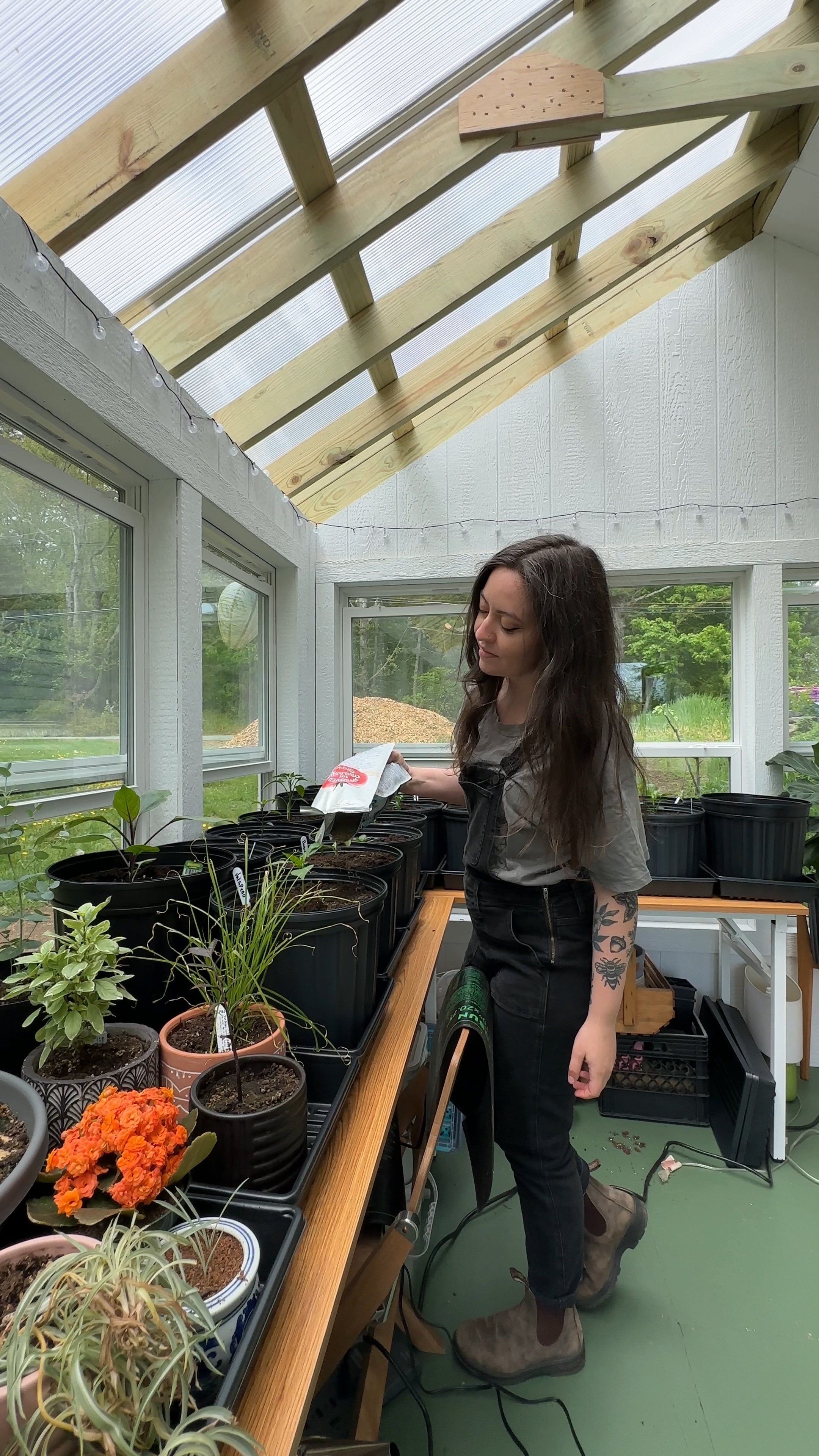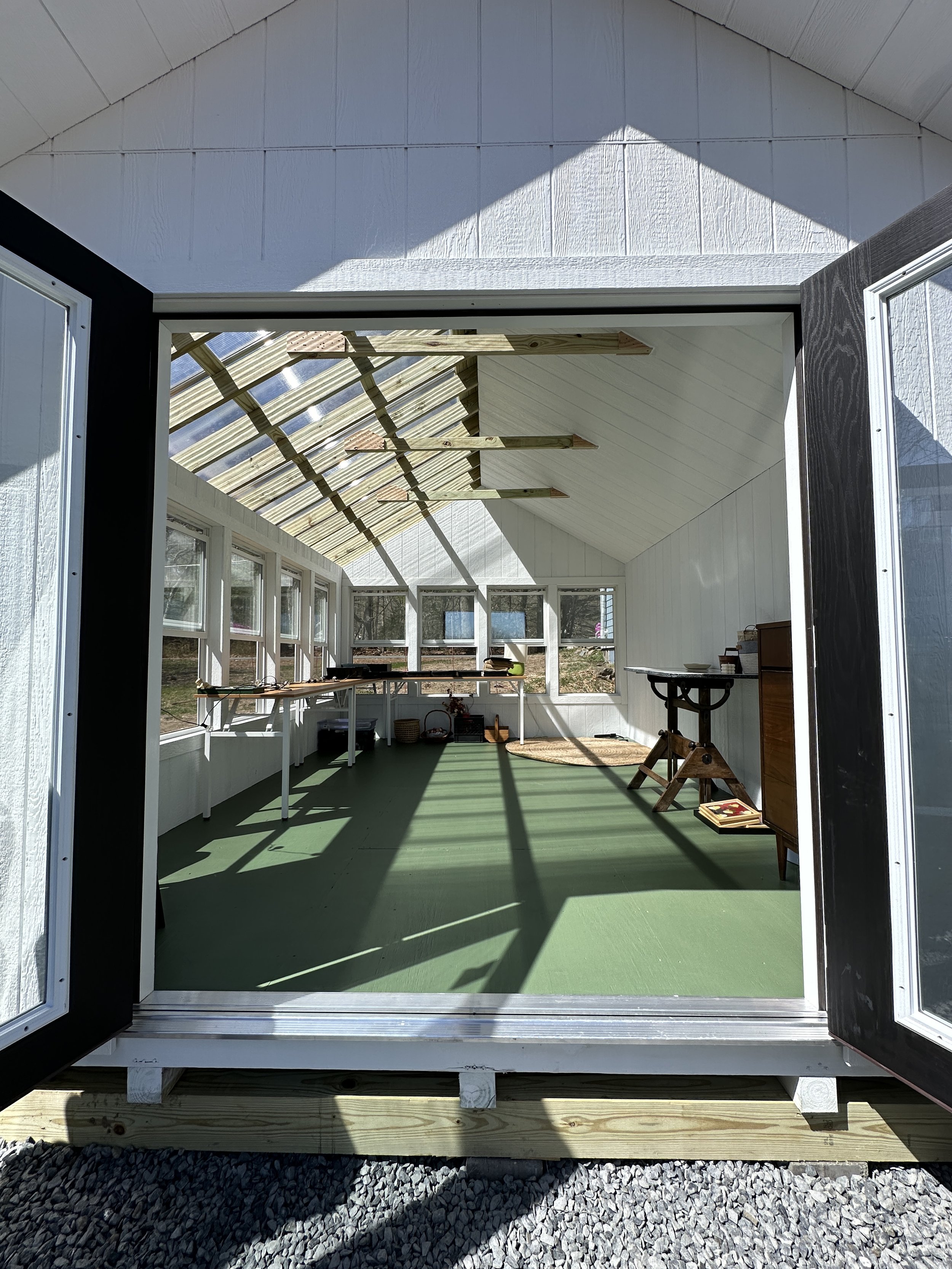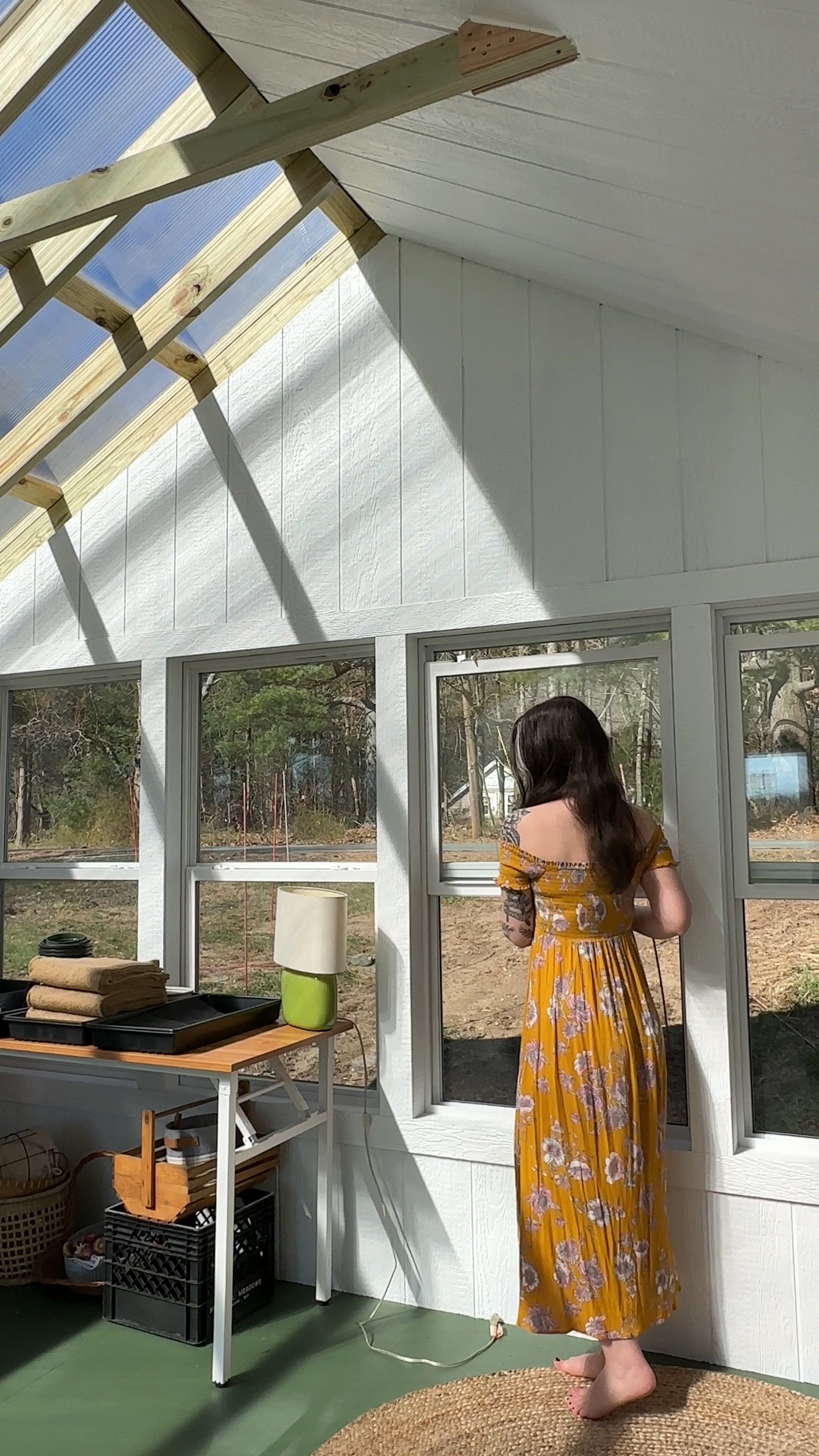Where To Put A Greenhouse [Hometown Structures]
Where Should You Put a Greenhouse?
Probably the most important decision you will make in the process of designing, building and installing a greenhouse is choosing exactly where the final greenhouse structure will go. Pick the wrong spot and you’ll struggle with everything from temperature regulation to plant health to day to day functionality. Pick the right spot, and your greenhouse garden will be able to thrive.
The elements ultimately dictate the best spot for your greenhouse more than any other factor, because sun and wind impact plant health the most. You probably already know that plants use sunlight as the primary energy source for photosynthesis, the process by which they convert light energy into food (glucose) - and adequate sunlight is vital for healthy growth, strong stems, and proper flower and fruit development. The amount of light a plant needs varies depending on the species. Some plants thrive in full sun, while others prefer partial shade. The total daily duration of sunlight also plays a role, with longer daylight hours generally promoting increased growth and productivity. But we want to be able to grow the widest variety of plants possible, so we need to learn the sun’s habits in your sky.
How to Track Your Sunlight
The sun's position in the sky changes throughout the day and seasons, and the intensity of sunlight varies depending on the time of day. Midday sun provides the strongest light, while morning and afternoon sun are less intense. Plants may have different needs for high-intensity vs. lower light periods. Throughout the day, surrounding structures and trees may cast shadows on your planting area. Knowing how these shadows move is essential to ensure your plants receive adequate sunlight during critical growth periods. Plus, the length of daylight hours changes significantly throughout the year.
There are several tools available to help you track sunlight patterns for your specific location. Websites and mobile apps allow you to enter your address and see the path of the sun across the sky at different times of the day and throughout the year. This helps visualize shading patterns and sunlight duration. Sunlight maps provide information about average daily sunlight hours in different regions. They can be helpful for understanding broad sunlight patterns in your area.
Ideal Sunlight Conditions for a Greenhouse
Plants have varying sunlight needs depending on the species. Full sun plants require at least 6-8 hours of direct sunlight daily for optimal growth and production. Examples include tomatoes, peppers, eggplants, most herbs, and many flowering plants. Partial shade plants prefer 4-6 hours of direct sunlight daily, with some protection from the afternoon sun. Examples include lettuce, spinach, kale, some herbs, and certain shade-tolerant flowers. Full shade plants thrive in areas with little to no direct sunlight. Examples include hostas, ferns, begonias, and impatiens.
Beyond these categories, some plants have even more specific sunlight preferences. Day length-sensitive plants require a specific number of daylight hours to flower or fruit. For example, some vegetables need long days to trigger flowering, while others are day-neutral and will flower regardless of day length.
What about wind?
Strong winds can physically damage delicate leaves and stems, stunt growth, and even uproot young plants. Excessive wind can also increase water loss through transpiration, stressing the plant. However, gentle air movement is beneficial for plants. It helps to strengthen stems, discourages fungal diseases (which thrive in still air), and aids in pollination. You should try to identify the prevailing wind directions in your backyard before deciding where to put a greenhouse. Prevailing winds are the winds that blow most frequently from a particular direction in your location. Knowing this helps you in several ways - Ideally, the long axis of your greenhouse should run perpendicular to the prevailing winds (but sun direction should take precedent). This allows wind to flow smoothly past the sides, minimizing stress on the structure, and through open doors and windows you can also position vents and fans to take advantage of prevailing winds for natural ventilation, drawing out hot air during warm seasons.
Strategically placed windbreaks can help to deflect strong winds away from the greenhouse structure while still allowing for air circulation through vents on the opposite side. Natural ventilation is most effective on breezy days. For consistent climate control, consider using a combination of natural ventilation and supplemental fans or ventilation systems, especially during calm periods or hot weather.
Making Your Greenhouse Accessible
Easy access to your plants allows for regular monitoring of their health, timely watering and fertilization, and prompt identification and treatment of any pest or disease problems. When you can easily reach your plants, you're less likely to cause accidental damage while tending to them. This minimizes stress on the plants, allowing them to focus their energy on growth and production. A well-placed greenhouse not only provides the perfect environment for your plants but also ensures ease of use and enjoyment.
Importance of Easy Access to Water for Irrigation
Greenhouse plants often require frequent watering, especially during hot weather or when growing water-loving plants. Having a close water source minimizes the time and effort spent on watering, allowing you to focus on other aspects of plant care. Easy access to water encourages consistent watering practices, reducing the risk of underwatering or overwatering your plants. Underwatering can stress plants and stunt growth, while overwatering can lead to root rot and other problems.
The ideal irrigation system for your greenhouse depends on its size, water source proximity, and the type of plants you grow. If your greenhouse is close to an outdoor faucet, you can directly connect a hose for watering. This is a simple and cost-effective solution for small greenhouses.
Installing a rainwater harvesting system can provide a sustainable source of water for your greenhouse, especially if you have a nearby roof or gutters. This is an eco-friendly option that reduces reliance on municipal water supplies.
For larger greenhouses or those located farther from a water source, a drip irrigation system can be a water-saving and efficient solution. Drip irrigation delivers water directly to the base of each plant, minimizing waste and maximizing water uptake by the roots.
Ease of Transporting Supplies
Greenhouse gardening often involves moving supplies like potting mix, fertilizer, tools, and harvested produce. A convenient location minimizes the distance you need to travel with these items, saving time and effort. Consider how you will transport larger items like bags of potting mix or wheelbarrows full of plants. Having a clear path and easy access to the greenhouse entrance is important. Wide doorways and walkways will make it easier to maneuver these items.
Does soil quality matter in a greenhouse?
If you plan on planting directly into the ground inside your greenhouse, good quality soil is essential for optimal plant growth. The soil should be fertile, well-draining, and have the appropriate pH level for your chosen plants. If the existing soil quality is poor, you may be able to amend it by adding organic matter like compost or aged manure. However, extensive amendments can be time-consuming and labor-intensive. In some cases, it might be easier to bring in fresh, high-quality topsoil.
Poor drainage can lead to waterlogging, where the soil becomes saturated and suffocates plant roots. This can cause root rot and hinder plant growth. A well-draining location is crucial for healthy plants. Ideally, the greenhouse should be placed on level ground to ensure proper water flow and drainage. Uneven ground can create pockets of waterlogging in low-lying areas.
If the existing soil is unsuitable or amending it seems impractical, you can opt for container gardening within your greenhouse. This allows you to use high-quality potting mix specifically chosen for your plants' needs.
Before finalizing your greenhouse location, it's wise to conduct a soil test. This will reveal the existing soil quality, pH level, and nutrient content. The test results can guide you in deciding whether amending the soil, bringing in topsoil, or opting for container gardening is the best approach. If the chosen location has good soil quality but poor drainage, consider grading the land to improve water flow away from the greenhouse. Installing drainage ditches or a French drain system can also be helpful.
How Does Climate Impact Greenhouse Location?
Understanding your local climate will help you create a greenhouse environment that thrives year-round. Research the average high and low temperatures in your area throughout the year. This will help you determine the heating and cooling needs for your greenhouse. Consider the potential for extreme temperatures, both hot and cold. This will help you choose appropriate ventilation strategies and select greenhouse materials that can withstand these extremes.
Even within a specific climate zone, there will be variations throughout the year. The angle of the sun changes throughout the year. In some cases, strategically positioning your greenhouse can take advantage of seasonal sunlight variations. For example, a south-facing greenhouse might be ideal for maximizing winter sunlight in colder climates. For hot summer months, consider implementing temporary shade solutions like shade sails or retractable awnings. This can help regulate temperature and prevent scorching of plants.
Zoning rules and your greenhouse
Before finalizing your greenhouse location, it's crucial to understand any zoning regulations and permitting requirements that might apply in your area. Different zoning districts may have regulations regarding the size, location, and type of structures allowed. These regulations can impact where you can place your greenhouse on your property. For example, there might be restrictions on how close the greenhouse can be to property lines or setbacks from the street.
Greenhouse classification: Depending on the size and intended use of your greenhouse, it might be classified as an accessory structure or a commercial operation. This classification can influence the applicable regulations.
Most localities require permits for building permanent structures, including greenhouses. The specific permit requirements can vary depending on the size and complexity of your greenhouse. The best way to determine the specific zoning regulations and permitting requirements in your area is to contact your local building department or zoning office. They can provide you with detailed information and any necessary forms or applications. Many municipalities have their zoning codes and permit information available online, but if you're unsure about the regulations or the permitting process, consider consulting with a contractor or architect familiar with local building codes. They can help you navigate the process and ensure your greenhouse project complies with all applicable regulations.
Future Proof Your Greenhouse
Greenhouses are long-term investments, and your needs and gardening aspirations may evolve over time. It’s important to future-proof your greenhouse by thinking ahead and planning for growth. Choose a location that allows for potential expansion of the greenhouse structure in the future. Consider how much additional space you might need to accommodate more plants, add work areas, or incorporate storage solutions. Think about whether you might want to add features like a potting bench, cold frame, or misting system in the future. Leaving some extra space around the perimeter will allow for these potential additions. That’s why it’s important to choose a location that provides easy access to all sides of the greenhouse. This will be helpful if you need to make modifications to the structure, electrical wiring, or ventilation system in the future. If you anticipate needing additional electrical outlets, water spigots, or heating elements in the future, consider burying conduit lines during initial construction. This will minimize disruptions when adding these features later.




